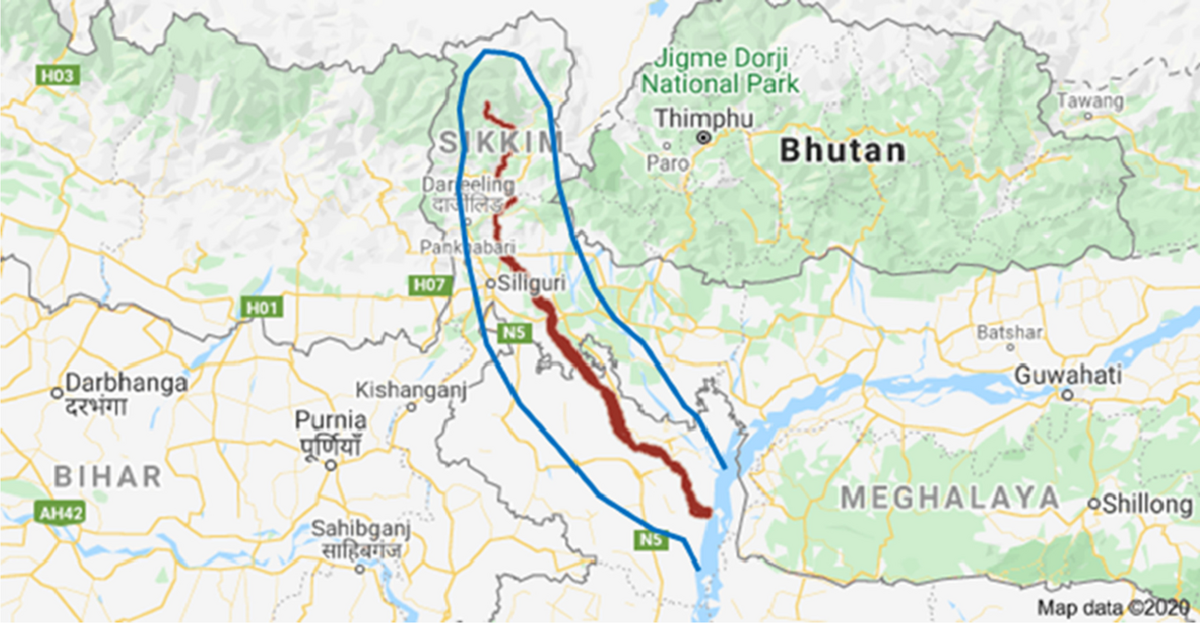Teesta-3 Dam: Climate Risks, Rebuilding Concerns, and Sustainability
Syllabus:
GS-1:
Water Resources
GS-3:
Disaster Management ,Infrastructure
Focus:
On January 27, 2025, a government expert committee recommended rebuilding the Teesta-3 dam in Sikkim, which was destroyed in October 2023 by a Glacial Lake Outburst Flood (GLOF). The decision, based on the dam’s commercial viability, has raised concerns over climate risks, environmental sustainability, and long-term safety.
About Teesta-3 Dam and the Long Shadow of Climate Change:
The Destruction of Teesta-3 Dam
- On October 2023, a Glacial Lake Outburst Flood (GLOF) from South Lhonak Lake led to the destruction of the Teesta-3 Dam in Sikkim.
- The event caused over 100 deaths and impacted 80,000+ people across four districts.
- The flood also carried dam debris downstream, worsening the damage.
The Decision to Rebuild
- On January 27, 2025, an expert committee under the Ministry of Environment, Forests, and Climate Change recommended rebuilding the dam.
- The committee justified the decision based on the dam’s commercial viability and the fact that its power-generating equipment remained intact after the flood.
- However, environmental experts and activists raised concerns over the risks of rebuilding.
Teesta River: Key Facts and FeaturesOrigin● The Teesta River originates from Tso Lhamo Lake in the Himalayas, near the Pahurni and Khangse glaciers in Sikkim. States It Passes Through● Sikkim and West Bengal in India. ● Enters Bangladesh before merging with the Brahmaputra (Jamuna) River. Tributaries● Left-bank Tributaries: Lachung Chhu, Chakung Chhu, Dik Chhu, Rani Khola, Rangpo Chhu. ● Right-bank Tributaries: Zemu Chhu, Rangyong Chhu, Rangit River. End Point● The Teesta River merges with the Brahmaputra (Jamuna) in Bangladesh. Unique Features● Vital for Agriculture & Hydropower: ○ Supports irrigation and hydroelectric projects in India and Bangladesh. ● Glacial Lake Outburst Flood (GLOF) Risks: ○ Highly prone to flash floods from melting glacial lakes (e.g., 2023 Sikkim disaster). ● Disputed Water Sharing: ○ India and Bangladesh have ongoing negotiations over Teesta water-sharing, impacting bilateral relations. |
The Role of Climate Change:
Increasing Glacial Melting
- Global warming is accelerating Himalayan glacier melt, leading to the formation and expansion of glacial lakes.
- A 2024 report by the Central Water Commission found that:
- Glacial lakes and water bodies in the Himalayan region increased by 8% (2011-2024).
- Their combined surface area expanded by 7% in the same period.
- South Lhonak Lake, formed in the 1960s, expanded to 167 hectares by 2023.
Risk Amplification by Climate Change
- Climate change is a risk-multiplier, affecting:
- Geological stability (triggering landslides and slope failures).
- Extreme weather events (intensifying floods and rainfall unpredictability).
- Riverbank collapses and sediment transport, altering flood impact.
- Experts argue that rainfall alone could not have caused the 2023 GLOF, suggesting complex interactions between climate change and geological instability.
Concerns Over Rebuilding Teesta-3:
Environmental and Structural Risks
- Teesta-3 Dam is located in an area prone to:
- Earthquakes
- Landslides
- Glacial lake floods
- The dam’s previous structure (a mix of concrete and rocks) failed against the GLOF.
- The new design (Teesta-3 2.0) proposes:
- A fully concrete structure.
- A spillway three times larger.
- An early-warning system.
- However, climate change could create new, unforeseen risks, making even the improved design vulnerable.
Public Interest and Legal Issues
- Multiple public interest litigations (PILs) have questioned the dam due to:
- Non-compliance with a 1996 notification requiring Sikkim to hold 51% equity.
- Allegations of corruption.
- Lack of proper techno-economic clearance.
Questioning the Justification
- The committee’s reasoning that Teesta-3 was “commercially viable” before the flood is considered weak.
- Hydroelectric power demand is rising, but experts stress that risk reduction should take priority over economic factors.
Expert Opinions and Alternative Approaches:
Flaws in Risk Assessment Models
- Many experts argue that:
- Current GLOF models fail to account for sediment transport, erosion, and landslides.
- Climate models struggle to predict extreme rainfall events
- Local weather stations recorded only moderate rainfall during the 2023 flood, raising doubts about its cause and predictability.
The Need for a Holistic Approach
- An international study (January 30, 2025) involving:
- IIT Bhubaneswar, IISc Bengaluru, the Indo-Tibetan Border Police, and the Sikkim Government
- Concluded that current flood assessment methods are inadequate.
- Suggested incorporating a comprehensive risk determination framework:
- Social security planning for affected communities.
- Clear “unacceptable risk” thresholds for infrastructure projects.
- A response matrix for potential disasters.
Alternative Solutions
- Instead of rebuilding, consider alternative strategies:
- Smaller hydro projects with lower environmental risks.
- Diversifying power sources (solar, wind, micro-hydro).
- Improving regional resilience to climate disasters.
- Brian Stone Jr. (Georgia Institute of Technology) emphasized that:
- Engineering solutions alone cannot counter climate change.
- Retreat from high-risk zones may become inevitable over time.
Social and Economic Implications:
Impact on Local Communities
- Livelihoods and property were severely affected in the 2023 disaster.
- If Teesta-3 2.0 fails, the consequences could be even worse.
- The economic burden of risk mitigation should not be externalized—it must be factored into hydroelectric tariffs.
Long-Term Sustainability
- India’s energy needs are increasing, but so are climate risks.
- Infrastructure projects must:
- Balance energy production with environmental risks.
- Integrate disaster preparedness into planning.
- Sustainability should guide decision-making, not just profitability.
Conclusion:
The decision to rebuild Teesta-3 based on commercial viability alone is short-sighted. Climate change is amplifying risks, making traditional risk assessments inadequate. A comprehensive approach—integrating scientific risk evaluation, alternative energy sources, and community resilience—is essential for sustainable development in fragile Himalayan regions.
Source: TH
Mains Practice Question:
Discuss the challenges of rebuilding the Teesta-3 Dam in the wake of climate change. How do extreme weather events impact Himalayan infrastructure? Suggest alternative solutions to balance energy security and environmental sustainability, considering the risks posed by glacial melt, geological instability, and hydropower projects.




